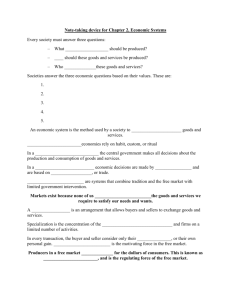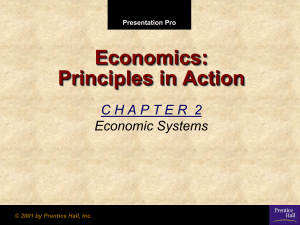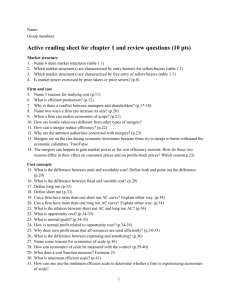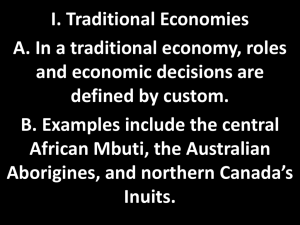Education Standards Addressed
advertisement
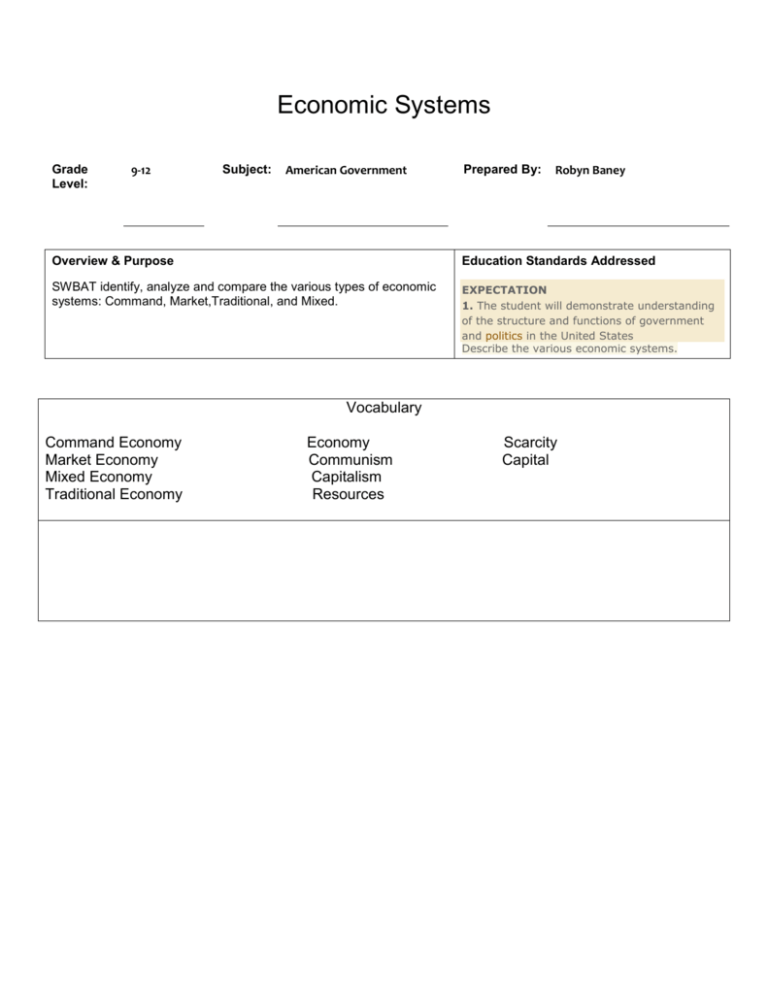
Economic Systems Grade Level: 9-12 Subject: American Government Prepared By: Robyn Baney Overview & Purpose Education Standards Addressed SWBAT identify, analyze and compare the various types of economic systems: Command, Market,Traditional, and Mixed. EXPECTATION 1. The student will demonstrate understanding of the structure and functions of government and politics in the United States Describe the various economic systems. Vocabulary Command Economy Market Economy Mixed Economy Traditional Economy Economy Communism Capitalism Resources Scarcity Capital Objectives (Specify skills/information that will be learned.) Information (Give and/or demonstrate necessary information) Students will be able to differentiate between the various economic systems Students will be able to recognize the elements of the various economic systems through scenarios/ descriptions Students will watch the video, Return to Mocha, for an overview of the types of economic systems. Students will take notes on a graphic organizer using words, pictures or symbols to describe each economic system. Students will be prepared to discuss. Materials Needed Paper Pencil Crayons, colored pencils, markers Computer access Smartboard Construction paper for vocabulary foldables Students will take notes from a powerpoint presentation (modified from the MSDE website) on the elements of the major types of economic systems. Verification (Steps to check for student understanding) Activity (Describe the independent activity to reinforce this lesson) Students will be asked, verbally, to demonstrate that they understand key vocabulary during the notes/handout section. As a class, we will complete a short worksheet to ensure understanding using scenarios to demonstrate understanding. Students will have two choices. They can either complete a webspiration to demonstrate their understanding of economic systems or they may complete paper-based picture definitions. For extra credit, students can create flashcards using flashcardminer.com. Other Resources (e.g. Web, books, etc.) Computer with internet access http://www.studyminder.com/flashcards.htm l vocabulary terms www.youtube.com Webspiration account Summary Day 1- Students will begin the lesson with an HSA released question for their warmup. After going over warm-up, students will watch the video, The Return to Mocha, to get an overview of economic systems. Students will take notes during the video using words, symbols or pictures. Following the video, the teacher will lead a class discussion and assess understanding of the material covered in the video. As a closing activity, students will complete a foldable using the key vocabulary that was introduced in the video. Day 2- Students will begin the lesson with an HSA released questions for their warm-up. After going over the warm-up, the students will take notes from a powerpoint presentation (based on a modified MSDE lesson) on types of economies. The teacher will direct students through the types of economies worksheet practice to ensure understanding. As a culminating activity, students will demonstrate understanding by completing a webspiration or paperbased picture definitions. Day 3- The students will be assessed with a short quiz of HSA style questions to unsure understanding. Additional Notes Prior knowledge of the meaning of the basic economic questions is necessary. Students need to understand what it means when asked what to produce, when to produce, and for whom to produce. Graphic Organizer to be used with video Return to Mocha. Students can use words, symbols or pictures to take notes as they watch the movie. Type of Economy Free Market (Mocha) Traditional (Oregano Island) Command (Caraway Island) Mixed (United States) Characteristics Graphic organizer to be completed from reading or Powerpoint notes. Types of Economies Traditional Economy What to Produce? How to Produce? For Whom to Produce? Strengths and Weaknesses of this system Command Economy Market Economy Reading to complete notes. Students can chose to take the notes from the powerpoint or the reading. Types of Economies Traditional Economy In a traditional economy, economic questions are answered by what happened in the past, by customs, and by tradition. The economy will produce what was made in the past, will make it the way it was made in the past, and the same people will receive what was made in the past. Individuals who live in traditional economies live comfortably. However, these economies typically lack many productive resources. These individuals and society exist at a level where they only produce enough to live on. If there is not enough produced for sustaining the group, some people may leave the society or die. If there is overproduction and extras were created, the extras will still be distributed based on the traditions. Traditional economies are found in remote areas, such as the Guatemalan highlands, the Brazilian rainforest, the Himalayan Mountains, or Indonesian jungles. These groups generally focus their activities on hunting, fishing, or farming. Command Economy In a command economy, the government answers the four basic economic questions. The government prepares detailed plans about what to produce, how to produce it, how much to produce, and for whom to produce it. Historically, China, the former Soviet Union, and Eastern Europe relied on command economies. However, problems with meeting production goals such as shortages and surpluses caused economic instability in these countries. The government planners often ignored the needs and wants of the people when developing plans. Environmental abuses also caught up with many of these countries. Trade pressures from other countries in the global market forced additional change. Today, Cuba and North Korea operate under a command economy. Market Economy In a market economy, buyers and sellers answer the four basic economic questions. A market economy is a lot like casting a vote for a political candidate. When buyers go to the store and buy goods and services, they are choosing the goods and services they want. If producers want to make money, they will interpret what the buyers want. When producers make correct interpretations of the market, they will produce the things that buyers want and demand in the correct quantities. If the producers make too little or too much of a good or service, they will not make a profit. Producers are motivated to make a profit when selling their goods and services. Sometimes this desire to make money has led to business abuses, such as poor quality goods and services, illegal business activity, and paying workers low wages. In addition, buyers' wants and desires are always changing and sometimes these changes occur quickly. Producers often can not keep up with buyers and their businesses fail. Today, the United States and Japan operate market economies. Practice worksheet to be completed as a class after the students have taken Powerpoint or reading notes. Name__________________________ Types of Economies Practice Use the reading and your chart to determine which type of economy the following statements are describing and why. Write T for traditional, C for command, and M for market. 1. Ralph becomes a police officer because his father was one as were all of the men in his family. Which type of economy is being described? a. Traditional b. Command c. Market Explain why: 2. Alice thinks Burtonsville needs a discount computer store so she decides to start her own business. Which type of economy is being described? a. Traditional b. Command c. Market Explain why: 3. Troy decides not to buy a new car because it costs too much. Which type of economy is being described? a. Traditional b. Command c. Market Explain why: 4. A planning commission decided how much coal should be produced. Which type of economy is being described? a. Traditional b. Command c. Market Explain why: 5. Doctors are employed by the state and their fees are set by the government. Which type of economy is being described? a. Traditional b. Command c. Market Explain why: 6. The software for the new computer system was sold to the company that offered the highest price. Which type of economy is being described? a. Traditional b. Command c. Market Explain why: Use the reading and your chart to determine which type of economy the following statements are describing. Write T for traditional, C for command, and M for market. 1. The first harvest of grapes went, as is custom, to the elders in the town. 2. The first harvest was sold to the Sour Grapes Company since they offered the highest price. 3. The Federal Farm Bureau, a government agency, gave all of the first harvest to the northern counties. 4. At the auction the first harvest was sold to the highest bidders- a group of foreign businessmen. 5. The first harvest fell short of the planners’ goals and concerns about how to continue the plan have developed. Quiz to assess student understanding of material. Quiz 6.1 Name____________________________________ 1. A company decides to build a new factory and hire more workers. Which economic question is being directly addressed? A. B. C. D. what to produce. how to produce. for whom to produce. how much to charge 2. A traditional economy is an economic system A. B. C. D. that exists mainly in underdeveloped countries. made up of elements of command and free market economies. dominated by government regulation. dominated by individuals competing for profits. 3. Which of the following is a characteristic of a free market economy? A. B. C. D. the government guarantees full employment. business decisions are controlled by government committees. most economic decisions are based on cultural traditions. individuals are allowed to privately own businesses. 4. In which of the following economic systems does the government decide what products will be sold to consumers? A. B. C. D. mixed economy. traditional economy. command economy free market economy. 5. Which of the following is most commonly a role of the government in the United States economy? A. B. C. D. setting prices for goods. requiring factories to produce certain goods. determining where citizens may work. creating laws to ensure the safety of workers
